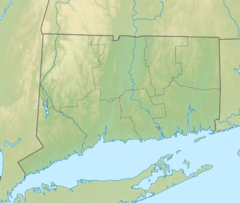Charter Oak Bridge
| Charter Oak Bridge | |
|---|---|
 |
|
| Coordinates | 41°45′11.6″N 72°39′13.53″W / 41.753222°N 72.6537583°WCoordinates: 41°45′11.6″N 72°39′13.53″W / 41.753222°N 72.6537583°W |
| Carries |
|
| Crosses | Connecticut River |
| Locale | Hartford, Connecticut |
| Official name | Charter Oak Bridge |
| Maintained by | Connecticut Department of Transportation [1] |
| Characteristics | |
| Design | Stringer/multibeam or girder |
| Total length | 3372.0 ft (1027.8 m) |
| Width | 47.9 ft (14.6 m) |
| Clearance below | 69 ft (21 m) |
| History | |
| Opened | 1991 |
The Charter Oak Bridge is one of the three highway bridges over the Connecticut River in Hartford, Connecticut. The twin steel stringer bridge carries (Route 15/U.S. Route 5) over the river, connecting downtown Hartford with East Hartford.
Named for Connecticut's famed Charter Oak, the original crossing opened as toll bridge in the early 1940s, allowing through traffic to pass south of downtown Hartford. It was replaced by the current bridge in 1991, which is free to motorists. The Charter Oak Bridge has an average daily traffic of 79,800.[2]
The first motor vehicle bridge across the Connecticut River at Hartford was the Bulkeley Bridge, which opened in 1908. In 1929 the Connecticut General Assembly passed an act creating a commission to study the need for a second bridge. The outcome was a proposed new bridge from Main and Pitkin Streets in East Hartford to Wyllys Street at Wethersfield Avenue in Hartford. In 1931 the commission hired a design consultant. The new design was an 800 feet (240 m) suspension span, with the eastern end shifted south to Main Street and Silver Lane. The project went to bid in 1933 and would cost $4.4 million. However, the Great Depression struck, banks were closed, and nothing further was done with the bridge until the decade was nearly over.
With the opening of the Merritt Parkway in 1940 and the construction of the Wilbur Cross Highway underway, the General Assembly authorized a new bridge commission, this time for a toll bridge that would carry the area's first expressways across the Connecticut River. The commission studied several sites and arrived at a Silver Lane to Wawarme Avenue alignment. In late 1940, construction began.
On Dec. 4, 1941, disaster struck, when a 222 feet (70 m) section of the Charter Oak Bridge fell into the Connecticut River during construction. Sixteen men fell to their deaths in the icy river, and 606 tons of steel, including a 176-ton derrick, plummeted into the water. One body was never recovered. Sixteen other men were rescued by the Hartford fire department.
...
Wikipedia

